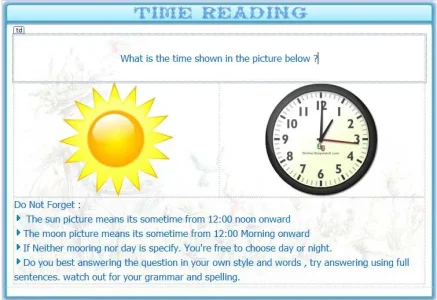I am a senior English teacher and I train other teachers. Here you are.
What time is it in the picture below?
Remember:
The sun picture means it is after 12:00 midday.
The moon picture means it is after 12:00 midnight but before 12.00 midday.
If neither is specified you are free to choose day or night.
Answer all questions in full sentences. Use your own style and your own words.
Check your grammar and spelling thoroughly after you finish.
I changed 'noon' to 'midday' as this is more usual modern usage. But if your lesson includes the word 'noon' change it. 'Noon' is used today, just rather less often.
I also thought the pair 'midnight/ midday' makes a good, clear point. 12 'o' clock often seems hard to understand but this makes it clear.
TIPS - for English learners, or for teaching English.
~ Always check that every sentence starts with a capital letter. This is considered 100% basic in English. Text without a starter capital letter looks extremely bad. This is unfair as many other languages do not use capitals at all. Also modern txt usually drops most capitals. But it is just how things are.
~ Use very short sentences. They protect you from complications of grammar. They force you to use fewer words which is clearer. They are also much easier for your students or readers to understand.
Short sentences also generally mean a better style in English, unlike German which favours long ones.
My guide to sentences is two lines maximum, preferably one. Paragraphs are best at a maximum of five lines. This also helps students to use paragraphs in an easy, mechanical way.
~ To strengthen this habit of short, clear sentences, do not use 'and' except for a pair or list. I teach all my students this. Use Ctrl+F on AND in final checks to locate any uses of 'and' to delete it. Make a new sentence instead. This is one of the most powerful yet simple ways to achieve good English.
~ It is best to check grammar and spelling after finishing the work. Trying to check the mechanics of language as we write obstructs the thinking about content (information). It is better in terms of brain function to look after content, that is write the answer first; then do checks at the end as a separate job.
~ The sequence for writing should be Plan (make a list of notes) Write Check.
~ As a teacher use positive commands in instructions e.g. "Remember:" instead of "Do not forget:" The brain welcomes positive commands. It finds 'do not' (negative commands) uncomfortable so will tend to avoid them. The unconscious even ignores the 'do not' to read the command 'do not forget' as 'forget'!
~ As a teacher omit 'please' or 'try to.' Strong students may appreciate the reminder but would probably do things correctly anyway. Students who need the reminder you are giving are weaker students. Weaker students will take any opportunity to assume that an instruction which demands effort is optional. Make it clear your instruction is not optional.
~ As a teacher leave a space between small groups of instructions. It makes it easier for the reader's brain to handle. Group by type. In your example I put the information about time in one group, with instructions about general language in the other.


